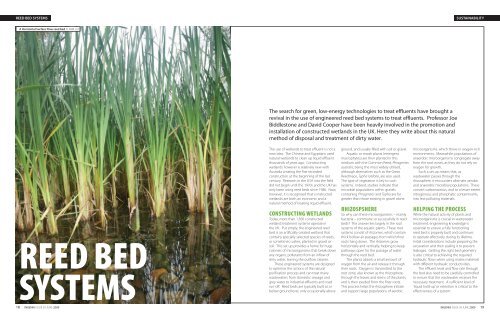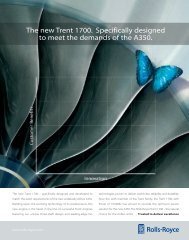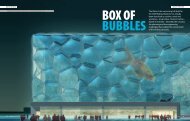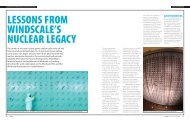reed bed systems - Ingenia
reed bed systems - Ingenia
reed bed systems - Ingenia
Create successful ePaper yourself
Turn your PDF publications into a flip-book with our unique Google optimized e-Paper software.
REED BED SYSTEMS<br />
SUSTAINABILITY<br />
A Horizontal Surface Flow <strong>reed</strong> <strong>bed</strong> © ARM Ltd<br />
The search for green, low-energy technologies to treat effluents have brought a<br />
revival in the use of engineered <strong>reed</strong> <strong>bed</strong> <strong>systems</strong> to treat effluents. Professor Joe<br />
Biddlestone and David Cooper have been heavily involved in the promotion and<br />
installation of constructed wetlands in the UK. Here they write about this natural<br />
method of disposal and treatment of dirty water.<br />
REED BED<br />
SYSTEMS<br />
The use of wetlands to treat effluent is not a<br />
new idea. The Chinese and Egyptians used<br />
natural wetlands to clean up liquid effluent<br />
thousands of years ago. Constructing<br />
wetlands however is relatively new with<br />
Australia creating the first recorded<br />
construction at the beginning of the last<br />
century. Research in the USA into the field<br />
did not begin until the 1970s and the UK has<br />
only been using <strong>reed</strong> <strong>bed</strong>s since 1986. Now,<br />
however, it is recognised that constructed<br />
wetlands are both an economic and a<br />
natural method of treating liquid effluent.<br />
CONSTRUCTING WETLANDS<br />
Today, more than 1,500 constructed<br />
wetland treatment <strong>systems</strong> operate in<br />
the UK. Put simply, the engineered <strong>reed</strong><br />
<strong>bed</strong> is an artificially created wetland that<br />
contains specially selected species of <strong>reed</strong>s,<br />
or sometimes rushes, planted in gravel or<br />
soil. This set up provides a home for huge<br />
colonies of microorganisms that break down<br />
any organic pollutants from an inflow of<br />
dirty water, leaving the outflow cleaner.<br />
These engineered <strong>systems</strong> are designed<br />
to optimise the actions of the natural<br />
purification process and can treat many<br />
wastewaters from domestic sewage and<br />
grey water to industrial effluents and road<br />
run-off. Reed <strong>bed</strong>s are typically built at or<br />
below ground level, only occasionally above<br />
ground, and usually filled with soil or gravel.<br />
Aquatic or marsh plants (emergent<br />
macrophytes) are then planted in this<br />
medium with the Common Reed, Phragmites<br />
australis, being the most widely utilised,<br />
although alternatives such as the Great<br />
Reedmace, Typha latifolia, are also used.<br />
The type of vegetation is key to such<br />
<strong>systems</strong>. Indeed, studies indicate that<br />
microbial populations within gravels<br />
containing Phragmites and Typha are far<br />
greater than those existing in gravel alone.<br />
RHIZOSPSHERE<br />
So why can these microorganisms – mainly<br />
bacteria – commune so successfully in <strong>reed</strong><br />
<strong>bed</strong>s? The answer lies largely in the root<br />
<strong>systems</strong> of the aquatic plants. These root<br />
<strong>systems</strong> consist of rhizomes, which contain<br />
thick hollow air passages from which finer<br />
roots hang down. The rhizomes grow<br />
horizontally and vertically, helping to keep<br />
pathways open for the passage of water<br />
through the <strong>reed</strong> <strong>bed</strong>.<br />
The plants absorb a small amount of<br />
oxygen from the air and release it through<br />
their roots. Oxygen is transmitted to the<br />
root zone, also known as the rhizosphere,<br />
through the leaves and stems of the plants,<br />
and is then exuded from the finer roots.<br />
This process helps the rhizosphere initiate<br />
and support large populations of aerobic<br />
microorganisms, which thrive in oxygen-rich<br />
environments. Meanwhile, populations of<br />
anaerobic microorganisms congregate away<br />
from the root zones, as they do not rely on<br />
oxygen for growth.<br />
Such a set up means that, as<br />
wastewater passes through the<br />
rhizosphere, it encounters alternate aerobic<br />
and anaerobic microbial populations. These<br />
convert carbonaceous, and to a lesser extent<br />
nitrogenous and phosphatic contaminants,<br />
into less polluting materials.<br />
HELPING THE PROCESS<br />
While the natural activity of plants and<br />
microorganisms is crucial in wastewater<br />
treatment, engineering knowledge is<br />
essential to ensure a fully functioning<br />
<strong>reed</strong> <strong>bed</strong> is properly built and continues<br />
to operate effectively during its lifetime.<br />
Initial considerations include preparing the<br />
excavation and then sealing it to prevent<br />
leakages. Getting the right <strong>bed</strong> geometry<br />
is also critical to achieving the required<br />
hydraulic flows when using matrix materials<br />
with different hydraulic conductivities.<br />
The effluent level and flow rate through<br />
the <strong>bed</strong> also need to be carefully controlled<br />
to ensure that the wastewater receives the<br />
necessary treatment. A sufficient level of<br />
‘liquid hold-up’ or retention is critical to the<br />
effectiveness of a system.<br />
18 INGENIA ISSUE 39 JUNE 2009 INGENIA ISSUE 39 JUNE 2009 19
REED BED SYSTEMS<br />
SUSTAINABILITY<br />
BUILDING A REED BED<br />
1. Immediately after planting. The <strong>reed</strong>s are<br />
planted in a medium of gravel, sand, and soil<br />
2. Six months after planting. Reed shoots and<br />
rhizomes begin to create an aerobic zone to<br />
support the growth of microorganisms<br />
3. Twelve months after planting. The <strong>reed</strong>s<br />
are fully grown and have established the<br />
necessary conditions to remove pathogens and<br />
suspended solids from wastewater<br />
HORIZONTAL FLOW BEDS<br />
Several types of <strong>reed</strong> <strong>bed</strong> exist, categorised<br />
according to hydraulic flow, such as horizontal<br />
flow, vertical flow, surface flow, and hybrid<br />
<strong>bed</strong>s. Horizontal flow <strong>bed</strong>s are the most<br />
common type in the UK and are used<br />
for a range of wastewater treatments.<br />
Typical examples include tertiary wastewater<br />
treatment – removing effluents from<br />
upstream treatment processes – as well as<br />
the secondary treatment of stronger polluting<br />
liquids such as industrial or septic tank<br />
effluents. These <strong>systems</strong> are also used to<br />
treat grey water from washbasins, showers<br />
and baths, and storm waters.<br />
A typical horizontal flow <strong>bed</strong> consists<br />
of a soil or gravel matrix in which the <strong>reed</strong>s<br />
are planted. UK <strong>systems</strong> use predominantly<br />
gravel media. The wastewater is fed onto<br />
the inlet end of the <strong>bed</strong>, flows through this<br />
matrix and emerges at the exit end<br />
of the <strong>bed</strong>. The matrix is kept flooded with<br />
the water surface less than 5 cm below the<br />
surface of the gravel media.<br />
One recent example is a <strong>reed</strong> <strong>bed</strong> in<br />
Berkhamsted, Hertfordshire (see over page),<br />
owned by UK water company, Thames Water.<br />
Commissioned in 2008 and designed for ARM<br />
Reed Beds by one of the authors, the subsurface<br />
horizontal flow <strong>reed</strong> <strong>bed</strong> is used for<br />
the tertiary treatment of sewage, specifically<br />
for foam and ammonia removal.<br />
Horizontal Flow Reed <strong>bed</strong> schematic. Effluent is distributed along the width of the <strong>bed</strong> and flows beneath the gravel towards the outlet. The water level in the HF<br />
<strong>bed</strong>s are maintained just below the gravel surface so there is no free flowing water above the gravel. This level is controlled using a level control arm – at right of<br />
picture © ARM Ltd<br />
VERTICAL FLOW REED BEDS<br />
If one wants to deal with stronger effluents<br />
and have less space, then vertical flow <strong>reed</strong><br />
<strong>bed</strong>s can be a better option. These <strong>systems</strong><br />
are more complex to build than horizontal<br />
versions and the sizing of the <strong>bed</strong> area is<br />
crucial to provide treatment to specific<br />
standards.<br />
A vertical flow system is typically<br />
1 m deep and contains a range of matrix<br />
materials which are graded according to size.<br />
Large stones lie at the bottom of the <strong>bed</strong>,<br />
topped with smaller stones, typically 30 mm<br />
to 60 mm in diameter. Coarse gravel lies on<br />
top of this, with 6 mm pea gravel above this<br />
layer and sharp sand lying on the surface.<br />
The wastewater is distributed across the<br />
surface and flows down vertically through<br />
the layers of sand, gravel and stone. As with<br />
horizontal <strong>bed</strong>s, the network of rhizomes<br />
maintain hydraulic conductivity as well as<br />
supporting populations of aerobic bacteria.<br />
In such a set-up, the <strong>bed</strong> is intermittently<br />
dosed with wastewater which allows time<br />
for the effluent to percolate through the<br />
matrix. As the effluent drains out, air is<br />
drawn from the atmosphere into the <strong>bed</strong>,<br />
enhancing oxygen transfer through the<br />
system. Perforated pipes, set within the<br />
layers, allow further air ingress.<br />
This extra oxygen availability means<br />
vertical <strong>bed</strong>s provide good nitrification,<br />
or ammonia removal, as well as removal<br />
of biochemical oxygen demand (BOD)<br />
pollutants. Meanwhile, horizontal flow<br />
<strong>systems</strong> are more suited to removing<br />
biochemical oxygen demand pollutants<br />
and suspended solids (Tables 1 and 2).<br />
A vertical flow <strong>bed</strong>, also designed by ARM<br />
Reed Beds, is currently operating at Aldbrough<br />
gas storage works in Hull. Commissioned by<br />
UK-based engineering consultancy, Amec,<br />
for use by UK electricity and natural gas<br />
supplier, Scottish Southern Energy, the system<br />
treats wastewater containing methanol and<br />
benzene.<br />
Table 1: Removal mechanisims in engineered <strong>reed</strong> <strong>bed</strong>s<br />
Pollutant<br />
Removal process<br />
Suspended solids<br />
Sedimentation, filtration.<br />
Biochemical oxygen Degradation to CO 2 and H 2 O by microorganisms.<br />
demand<br />
Nitrogen<br />
Main removal by nitrification-denitrification. Ammonia<br />
oxidised to nitrate by nitrifying bacteria in aerobic zones.<br />
Nitrates converted to N 2 gas by denitrifying bacteria in<br />
anoxic zones. A little removal by plant uptake and ammonia<br />
volatilization.<br />
Phosphorus<br />
Adsorption, complexation, precipitation reactions within the<br />
<strong>bed</strong> matrix, particularly with Al, Fe, Ca and clay minerals. Very<br />
little plant uptake.<br />
Heavy metals<br />
Precipitation reactions after pH changes, sedimentation.<br />
Pathogens<br />
Sedimentation and filtration. Competition and natural dieoff.<br />
Excretion of antibiotics from roots of plants and from<br />
composting of plant litter on <strong>bed</strong> surface.<br />
Table 2: Removal of pollutants in engineered <strong>reed</strong> <strong>bed</strong>s (based on sewage)<br />
Bed type<br />
Removal<br />
Horizontal sub-surface<br />
flow<br />
The system was designed with a gravel<br />
matrix, planted with Phragmites australis.<br />
The <strong>bed</strong> area is relatively small, measuring<br />
210 m 2 and the average flow to the <strong>bed</strong> is<br />
0.6 m 3 /hr.<br />
Biochemical oxygen demand is 80-90%.<br />
Total Nitrogen: 30-40%.<br />
Total Phosphate up to 25%.<br />
Vertical flow For a two-stage process. Biochemical oxygen demand up to 93%,<br />
suspended solids up to 90%, ammonium compounds up to 75%.<br />
20 INGENIA ISSUE 39 JUNE 2009 INGENIA ISSUE 39 JUNE 2009 21
REED BED SYSTEMS<br />
SUSTAINABILITY<br />
A sub-surface horizontal flow system for the tertiary treatment of sewage. It comprises 10 horizontal<br />
flow <strong>bed</strong>s each of 1,600 m 2 giving a total surface area of 16,000 m 2 . The <strong>bed</strong> matrix is gravel and it is<br />
planted with Phragmites australis. The total flow rate to the <strong>bed</strong>s is 11,500 m 3 per day and the design<br />
purpose is to remove biological oxygen demand, foam and ammonia © ARM Ltd<br />
FUTURE DEVELOPMENTS<br />
Today, <strong>reed</strong> <strong>bed</strong>s are seen as a sustainable<br />
way to treat sewage. The majority of the<br />
operating <strong>reed</strong> <strong>bed</strong>s found in the UK are<br />
usually horizontal flow <strong>bed</strong>s for the tertiary<br />
treatment of sewage at small works;<br />
however, vertical flow <strong>bed</strong>s are becoming<br />
more widely used.<br />
Now, as the industry’s understanding of<br />
design principles increases, more and more<br />
interesting treatment <strong>systems</strong> are emerging<br />
all the time.<br />
For example, sludge-drying <strong>reed</strong> <strong>bed</strong>s,<br />
a modified version of the vertical <strong>bed</strong> and<br />
widely used in Denmark, are now being<br />
built in the UK. With this design, the<br />
sludge is distributed over the surface of the<br />
<strong>bed</strong> and the solids become trapped and<br />
gradually biodegrade. Meanwhile, any liquid<br />
percolates down through the <strong>bed</strong>, receiving<br />
a treatment before being returned to the<br />
<strong>bed</strong>’s inlet.<br />
Another design, the floating <strong>reed</strong><br />
<strong>bed</strong>, has been researched in Belgium.<br />
This consists of a buoyant, tubular<br />
framework inside which a coir mattress is<br />
fixed and across which the <strong>reed</strong>s are<br />
planted. The resulting raft literally floats on<br />
the water.<br />
This design is ideal for aerating ponds or<br />
lagoons and removing algal blooms. In fact,<br />
the <strong>bed</strong>s can also be designed to encourage<br />
or dissuade nesting birds while additional<br />
wetland plants can be added to the <strong>reed</strong>s to<br />
promote insect diversity.<br />
TICKING ALL THE BOXES<br />
Reed <strong>bed</strong>s treat effluent effectively, have a<br />
broad application range, and have low or no<br />
energy requirement: as long as gravity is on<br />
your side, no power is required. They have low<br />
maintenance costs, create wildlife habitats,<br />
offer sustainability, and are very robust.<br />
As the designs of <strong>reed</strong> <strong>bed</strong> develop and<br />
become increasingly sophisticated, more<br />
and different wastewaters are able to be<br />
treated. These include run-off from roads,<br />
airports, and vehicle-servicing areas as well<br />
as leachate from landfill sites and metalcontaminated<br />
effluents from operating and<br />
derelict mines.<br />
Over the past 30 years in Europe, these<br />
constructed wetland <strong>systems</strong> have been<br />
successfully harnessed to treat sewage<br />
and many other pollutants in wastewaters.<br />
Without a doubt, even greater potential<br />
remains for the engineered <strong>reed</strong> <strong>bed</strong>s of<br />
the future.<br />
HOW BIG IS A BED?<br />
Traditionally <strong>bed</strong>s have been constructed<br />
some 600 mm deep and 10 m to 15 m<br />
long. Many designs rely on operational<br />
data and experience from previous<br />
installations.<br />
The <strong>bed</strong> area needed is determined by<br />
the waste water flow rate and the required<br />
reduction in the polluting strength of<br />
the water, which is generally measured<br />
as biochemical oxygen demand (BOD),<br />
suspended solids (SS) and ammonia NH 4 N.<br />
BOD is the amount of oxygen required by<br />
aerobic microorganisms to decompose the<br />
organic matter in a sample of water, such<br />
as that polluted by sewage. It is used as a<br />
measure of the degree of water pollution.<br />
The cross-sectional area of the <strong>bed</strong> can<br />
be calculated using Darcy’s Law which<br />
describes the flow of a fluid through a<br />
porous medium, such as a granular <strong>bed</strong>.<br />
Based on Henry Darcy’s observations<br />
of water flow through <strong>bed</strong>s of sand<br />
(conducted back in 1856), the law relates<br />
the cross-sectional of the <strong>bed</strong> to fluid<br />
flow rate, hydraulic conductivity, and the<br />
hydraulic gradient.<br />
In sizing the <strong>bed</strong> it is recognised<br />
also that with time the <strong>bed</strong> matrix may<br />
become affected by the build up of<br />
solids. Although there is a limited level of<br />
self-cleaning, experience over the last 20<br />
years shows that for some installations the<br />
<strong>bed</strong> gravel may need to be removed and<br />
cleaned after 10-12 years operation.<br />
Further reference<br />
www.constructedwetland.co.uk<br />
www.arm<strong>reed</strong><strong>bed</strong>s.co.uk<br />
BIOGRAPHIES – Professor Joe Biddlestone<br />
and David Cooper<br />
Joe Biddlestone is Emeritus Professor of<br />
Chemical Engineering at the University<br />
of Birmingham and is a former Head<br />
of Chemical Engineering and Dean of<br />
Engineering at the University. He is the<br />
founding and former chairman of the<br />
Constructed Wetland Association. He is<br />
a chartered chemical engineer and has<br />
been researching the aerobic treatment<br />
of organic wastes for more than 30 years.<br />
David Cooper is Managing Director of<br />
ARM Ltd (ARM Reed Beds) and Secretary<br />
of the Constructed Wetland Association.<br />
David Cooper is a chartered engineer and<br />
chartered environmentalist. He has been<br />
at the forefront of wetland technology<br />
in the UK for more than 20 years. He<br />
has helped develop the product and<br />
the market and has designed more<br />
than 350 wastewater treatment <strong>systems</strong><br />
incorporating <strong>reed</strong> <strong>bed</strong>s.<br />
The authors would like to thank Dr Rebecca Pool<br />
for her help with this article.<br />
Floating <strong>reed</strong> <strong>bed</strong>s are a ‘soft engineering’ approach to treating effluent. The roots of the wetland plants<br />
encourage settlement of solids and provide enhanced treatment of BOD and ammonia, but they can also<br />
be used for the treatment of metals. These <strong>bed</strong>s can be installed on sludge lagoons, storm water storage,<br />
ponds, lakes, reservoirs and canals. They are ideal for sludge lagoons to aid the settlement of solids<br />
and for the treatment of surface water run-off, as the rafts are able to withstand fluctuating water levels<br />
caused by storm events © ARM Ltd<br />
22 INGENIA ISSUE 39 JUNE 2009 INGENIA ISSUE 39 JUNE 2009 23








![[322/03] Francke - Ingenia](https://img.yumpu.com/23411337/1/184x260/322-03-francke-ingenia.jpg?quality=85)







